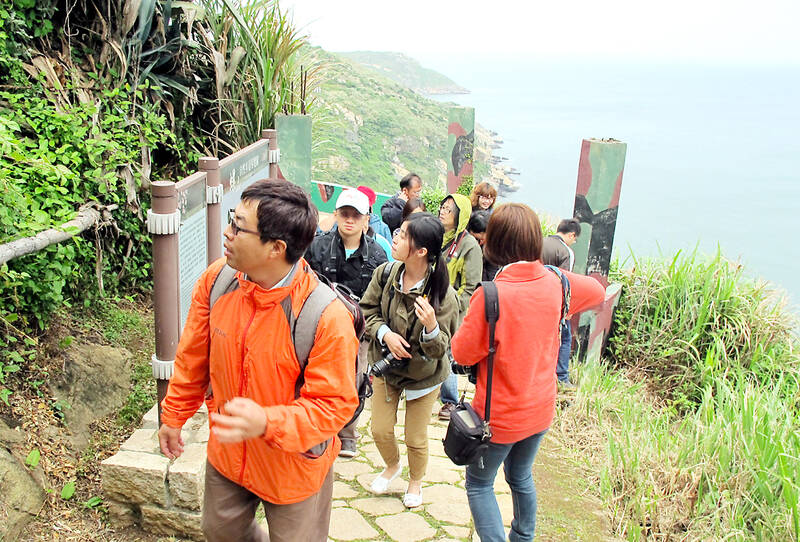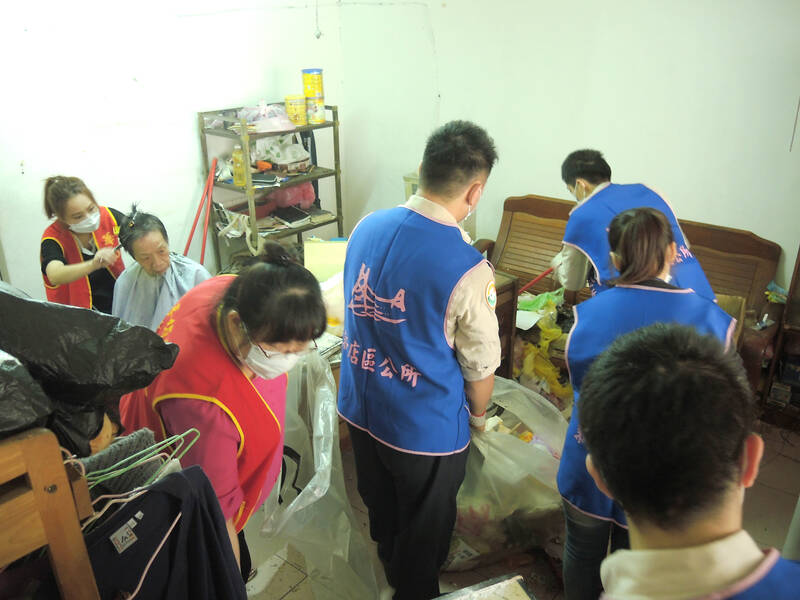For a short period last year, some Taiwanese hoped their country would become the first in Asia, and one of very few in the world, to make four days of work followed by a three-day weekend the default employment pattern.
Supporters claim that reducing the working week by a day, without reducing salaries or making each working day longer, is a win-win scenario for employees and employers. Workers get more free time; because they’re happier and healthier, they’re less likely to take sick leave; and despite working fewer hours in total, there’s evidence they’re actually more productive.
On March 7 last year, a petition posted on the National Development Council’s Public Policy Online Participation Platform asked the government to consider such a reform. Because more than 5,000 people registered their support for the proposal, the government was obliged to publish a formal response.

Photo: Steven Crook
What happened next didn’t surprise many people. The Ministry of Labor (MOL) rejected the proposal, saying the data accrued in trials and studies overseas is insufficient, and that it’d be inappropriate to implement any such policy before introducing supporting measures. What’s more, the MOL said, it’s unclear how a four-day work week would impact education, transportation, public services and the financial system.
The MOL’s statement noted that the existing “flexible working hours” (變形工時) framework in the Labor Standards Act already makes it possible to arrange four days of work per week by redistributing working hours. But, as Ray Cheng (鄭中睿), director of Taiwan Youth Labor Union 95 (台灣青年勞動95聯盟), points out, this kind of four-day routine won’t bring about any reduction in total working hours.
“It simply means that a worker has to work more hours per working day. I don’t think this is what the petition was really seeking,” Cheng says.

Photo: Steven Crook
OVERWORK
Taiwanese employees are among the world’s most overworked. There’s been a slight reduction in the amount of time people spend in their offices in recent years; even so, in 2022 the average was 2,007.6 hours of work. That’s 10 percent more than in the US and 21 percent higher than the EU average.
Cheng thinks the MOL’s response was more likely shaped by an unwillingness to consider such a major reform than by any misunderstanding of the petition.

Photo: Weng Yu-huang, Taipei Times
Local work culture may also make it difficult to shift to a shorter working week, he says. When companies in other countries that have successfully switched to a four-day work week, oftentimes the necessary improvements in efficiency were achieved as a result of bosses and staff together reviewing the work process.
“The traditional business model in Taiwan values managers’ authority, so I can’t see that kind of thing happening here,” Cheng says.
If English-language news reports are anything to go by, there’s considerable enthusiasm for the four-day work week across the developed world. Even the Web site of the World Economic Forum (WEF) recognizes the benefits of giving workers an extra day off each week, saying in October last year that it “actually increases productivity, boosts physical and mental health, and reduces CO2 emissions.”

Photo: Huang Ming-tang, Taipei Times
A 2011 conference paper published by the University of Massachusetts, Amherst concludes that a 10-percent reduction in work hours is associated with an 8.6-percent drop in carbon emissions and a 4.9-percent decline in ecological footprint. This environmental upside is achieved mainly by reductions in commuting and workplace electricity consumption.
Juliet Schor, one of the authors of that paper, explained in an April 2022 TED Talk that benefits for companies include lower employee turnover, fewer absences, less burnout (which reduces mistakes and poor service) and better job applicants.
“The secret sauce [to maintaining overall productivity] is work reorganization, cutting out the least productive activities… meetings are a prime target,” she said.
Not everyone is convinced. In an article last month published in the Hill, a US publication, academics Jose Maria Barrero and Steven J. Davis dismiss such thinking as “magical.” They stress “the reality that output and pay are roughly proportional to time spent working.”
Even though the duo’s research suggests that most of those who now work four days per week in the US spend nine or more hours at the office on each of those days, they acknowledge that such arrangements can reduce commuting time and expenditure. When they asked those on five-day schedules if they’d prefer to do just as many hours but spread over four days, “Nearly 60 percent said yes. They also said shifting to a four-day work week was worth as much, on average, as a 4-percent pay hike.”
DEGROWTH
Lu Chien-yi (盧倩儀), a research fellow at Academia Sinica’s Institute of European and American Studies, is cautious in her endorsement of a shorter work week.
As a supporter of the degrowth movement — which argues that the only way to avoid ecological catastrophe is to shrink the global economy (see “Degrowth or collapse: the choice facing humanity?” in the Sep. 27, 2023 Taipei Times) — Lu says she’s convinced people must work less, produce less and consume less.
“Over the past 20-plus years, degrowthers have done lots of research, and they’ve concluded that working time is positively related not only to environmental damage but also to inequality,” says the author of the 2020 book Surviving Democracy: Mitigating Climate Change in a Neoliberalized World.
Degrowth advocates call for the elimination of certain parts of the modern economy, such as fast fashion and the production of luxury cars.
“These do nothing for human wellbeing, they just boost somebody’s profits,” says Lu. “We should reduce work, while also spreading employment more evenly. This would enhance wellbeing, because people would have leisure time, more time to do volunteer work or take care of friends and family, and perhaps time to do some gardening or produce food.”
At the same time, there must be safety nets for low-wage workers in wealthy countries and for citizens of the Global South. As Lu points out, four-day work week trials have so far focused on white-collar workforces, “not people stitching clothes in Bangladesh, who might starve.”
Because universal basic income (UBI) could act as a consumption subsidy that exacerbates climate change, some degrowthers instead call for universal basic services (UBS), to ensure each person’s essential needs are met.
When people have more time, they’re more capable of behaving in ways that reduce their carbon footprint. They’re more likely to use public transportation instead of private vehicles, and cook at home rather than rely on food-delivery apps.
Yet those who can afford it may take more trips outside their home region, she concedes. “Because of this kind of ‘rebound effect,’ we need a lot more discussion and research before we can make any decisions,” she says.
Lu says she’s very intrigued to read what pro-business media, in Taiwan and elsewhere, are saying about the four-day work week. The fact that the WEF is talking it up “tells us a lot.”
She fears that a business-led reorganization of work patterns wouldn’t achieve environmental or social progress. It’d more closely resemble the Ford Motor Company’s shift to a five-day work week in 1926, which Henry Ford said was motivated by his belief that if employees had more leisure time, they’d buy more consumer goods. When business figures express support for a shorter work week, “that’s their logic, to increase both productivity and consumption. That’ll really damage the planet,” Lu says.
AI may lead to much greater unemployment, and Lu wonders if “the WEF and others are getting us used to there being fewer jobs, taking us even further from a people-centric system.”
“It’s very important that degrowth researchers and advocates talk more about this. Otherwise it’ll just be WEF-types, and the four-day work week will fulfill their dreams, not ours,” she says.
Steven Crook, the author or co-author of four books about Taiwan, has been following environmental issues since he arrived in the country in 1991. He drives a hybrid and carries his own chopsticks. The views expressed here are his own.

March 31 to April 6 On May 13, 1950, National Taiwan University Hospital otolaryngologist Su You-peng (蘇友鵬) was summoned to the director’s office. He thought someone had complained about him practicing the violin at night, but when he entered the room, he knew something was terribly wrong. He saw several burly men who appeared to be government secret agents, and three other resident doctors: internist Hsu Chiang (許強), dermatologist Hu Pao-chen (胡寶珍) and ophthalmologist Hu Hsin-lin (胡鑫麟). They were handcuffed, herded onto two jeeps and taken to the Secrecy Bureau (保密局) for questioning. Su was still in his doctor’s robes at

A vaccine to fight dementia? It turns out there may already be one — shots that prevent painful shingles also appear to protect aging brains. A new study found shingles vaccination cut older adults’ risk of developing dementia over the next seven years by 20 percent. The research, published Wednesday in the journal Nature, is part of growing understanding about how many factors influence brain health as we age — and what we can do about it. “It’s a very robust finding,” said lead researcher Pascal Geldsetzer of Stanford University. And “women seem to benefit more,” important as they’re at higher risk of

Last week the Democratic Progressive Party (DPP) said that the budget cuts voted for by the China-aligned parties in the legislature, are intended to force the DPP to hike electricity rates. The public would then blame it for the rate hike. It’s fairly clear that the first part of that is correct. Slashing the budget of state-run Taiwan Power Co (Taipower, 台電) is a move intended to cause discontent with the DPP when electricity rates go up. Taipower’s debt, NT$422.9 billion (US$12.78 billion), is one of the numerous permanent crises created by the nation’s construction-industrial state and the developmentalist mentality it

Experts say that the devastating earthquake in Myanmar on Friday was likely the strongest to hit the country in decades, with disaster modeling suggesting thousands could be dead. Automatic assessments from the US Geological Survey (USGS) said the shallow 7.7-magnitude quake northwest of the central Myanmar city of Sagaing triggered a red alert for shaking-related fatalities and economic losses. “High casualties and extensive damage are probable and the disaster is likely widespread,” it said, locating the epicentre near the central Myanmar city of Mandalay, home to more than a million people. Myanmar’s ruling junta said on Saturday morning that the number killed had